 |
 |
|
What to see Around our Towns & Villages | ||||||||||||||||||||||||||||||||||||||||||||||||||||||||||||||||||||||||||||||||||||||||||||||||||||||||||||||||||||||||||||||||||||||||||||||||||||||||||||||||||||||||||||||||||||||
|---|---|---|---|---|---|---|---|---|---|---|---|---|---|---|---|---|---|---|---|---|---|---|---|---|---|---|---|---|---|---|---|---|---|---|---|---|---|---|---|---|---|---|---|---|---|---|---|---|---|---|---|---|---|---|---|---|---|---|---|---|---|---|---|---|---|---|---|---|---|---|---|---|---|---|---|---|---|---|---|---|---|---|---|---|---|---|---|---|---|---|---|---|---|---|---|---|---|---|---|---|---|---|---|---|---|---|---|---|---|---|---|---|---|---|---|---|---|---|---|---|---|---|---|---|---|---|---|---|---|---|---|---|---|---|---|---|---|---|---|---|---|---|---|---|---|---|---|---|---|---|---|---|---|---|---|---|---|---|---|---|---|---|---|---|---|---|---|---|---|---|---|---|---|---|---|---|---|---|---|---|---|---|
| Bardwell is a pretty, well kept village in the north east of the borough. There is a fully working windmill built in 1825 and restored in the mid 1980's. It is now run as a family business making wholefoods, and visitors are welcome throughout the year to witness corn being ground as it was 150 years ago. Bardwell also has a very attractive 15th century church which is well worth a visit. | ||||||||||||||||||||||||||||||||||||||||||||||||||||||||||||||||||||||||||||||||||||||||||||||||||||||||||||||||||||||||||||||||||||||||||||||||||||||||||||||||||||||||||||||||||||||
| Bardwell Windmill is a fully working windmill, built in 1825 and restored in the mid 1980's. It is now run as a family business making wholefoods and visitors are welcome throughout the year to witness corn being ground as it was 150 years ago. | ||||||||||||||||||||||||||||||||||||||||||||||||||||||||||||||||||||||||||||||||||||||||||||||||||||||||||||||||||||||||||||||||||||||||||||||||||||||||||||||||||||||||||||||||||||||
| At Bradfield you will find Bradfield Woods, a splendid illustration of how a coppiced woodland looked in mediaeval times. A visitor centre and guided walks are provided for those wishing to find out more about this glimpse of the forests of old England. | ||||||||||||||||||||||||||||||||||||||||||||||||||||||||||||||||||||||||||||||||||||||||||||||||||||||||||||||||||||||||||||||||||||||||||||||||||||||||||||||||||||||||||||||||||||||
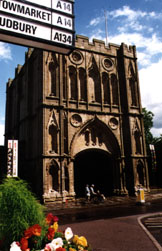
|
Bury St Edmunds is, in essence, a mediaeval town which grew up around the gates of the great Benedictine monastery founded in 1020 AD. Bury was a prosperous market town with a thriving clothmaking industry. St Mary's Church was built in the 15th century and it is here that Mary Tudor, sister of Henry VIII, is buried. Many mediaeval buildings such as the Guildhall still survive, but most are hidden behind elegant 17th and 18th century facades. The many splendid Georgian buildings in the town are a testimony to its prosperity in the 18th century. Daniel Defoe described Bury St Edmunds as "a town famed for its pleasant situation and wholesome air, the Montpelier of Suffolk and perhaps of England". Charles Dickens was a regular visitor to the town and in Pickwick Papers he calls Bury St Edmunds "a handsome little town, of thriving and cleanly appearance". The town has excellent leisure and shopping facilities. Wednesdays and Saturdays are market days when the town centre becomes a bustling arena for bargain hunters and bright market stalls, offering fresh local produce, antiques, armchairs or avocados. Bury St Edmunds is a shoppers' delight! Its rare mix of family-run businesses and high street names sit comfortably side by side, offering quality, choice, value and convenience.There is ample low-cost parking nearby, and you will find no shortage of museums, art galleries, theatre, cinemas, night-clubs, bars, and high brow recitals. | |||||||||||||||||||||||||||||||||||||||||||||||||||||||||||||||||||||||||||||||||||||||||||||||||||||||||||||||||||||||||||||||||||||||||||||||||||||||||||||||||||||||||||||||||||||
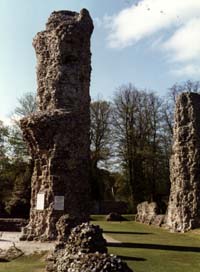 |
IN BURY ST EDMUNDS Bury St Edmunds itself retains its 12th century grid plan, making it easy to explore on foot and difficult to lose your way. Walking tours, either with Registered guides or with colourful characters from Bury's past, can be booked at Tourist Information points (2018 prices are £6 per adult, children free). Probably the most famous feature of the town is the Abbey Gardens, which surround the graceful ruins of one of the most powerful mediaeval monasteries in Europe. On Wednesdays and Saturdays, Bury hosts the biggest street market in East Anglia with stalls selling everything from Bonsai trees to biscuits. The attractive streets of Bury house many unusual shops, and an array of splendid mediaeval and georgian buildings. 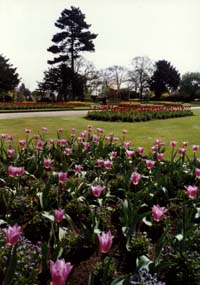
The Abbey Gardens are beautiful public gardens surrounding the ruins of the Abbey, with a prize-winning record. Stunning bedding displays between May and September set the tone for the annual Bury in Bloom campaign. The Gardens include a host of ducks, a children's play area, aviaries, tennis courts, putting, a bowling green, a teashop and a riverside walk leading towards a local nature reserve known as No Man's Meadows. There is a tea shop and ice cream kiosk. Free admission | Telephone: (01284) 757490
| (The Manor House on Honey Hill was a Public Museum from 1993 until 2006. Its collections have been moved into the Moyse's Hall Museum. In 2007 it was sold as a private house. Examples from these collections are now accessible via Moyse's Hall Museum.)
|
| Moyse's Hall Museum, Cornhill. The oldest house in Bury, this rare Norman building contains a wonderfully eccentric collection of local history artifacts and nationally important archaeological exhibits. A programme of exhibitions, workshops and lectures is available. Phone for details. | Telephone: (01284) 706183
| Greene King Brewery Museum, Westgate Street. A new museum celebrating Greene King's 200 years of brewing in Bury St Edmunds, charting the history of beer in the town. The museum has a contemporary feel with contemporary exhibits that make it relevant to anyone interested in beer. | Telephone: (01284) 714297
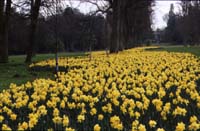 Nowton Park, Nowton Road, consists of almost 200 acres of Suffolk countryside, landscaped over one hundred years ago in typical Victorian style with 'country estate' features. Specimen trees and wild flowers are a feature, with a spectacular daffodil display in the spring. There is an all-weather sports pitch and a visitor centre, and guided walks are available. It is a 30 minute walk from the centre of Bury, and Eastern Counties bus BO1 stops nearby (ask for South Lees School). | Telephone: (01284) 763666
| The Nutshell, in the Traverse, is reputed to be the smallest pub in Britain; it is owned by Bury-based brewers Greene King. |
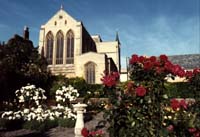 St Edmundsbury Cathedral, Angel Hill. A 16th Century building, magnificently transformed in this century from parish church into Cathedral by Stephen Dykes Bower. The picture shows the cathedral before the addition of a magnificant new tower, completed in 2005. One thousand needlepoint kneelers adorn the pews. | Telephone: (01284) 754933
For more detailed information & service times visit the Cathedral website.
| St Mary's Church, Angel Hill, was begun in the late 14th century and has an impressive interior, including a hammer-beam roof. Henry VIII's sister Mary Tudor is buried in the sanctuary. |
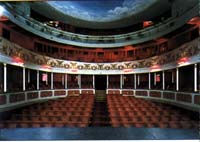 Theatre Royal (NT), Westgate Street. Dating back to the 18th century, this is the one of the oldest and smallest working theatres in the country. Brochures from the number below or the TIC. | Telephone: (01284) 769505
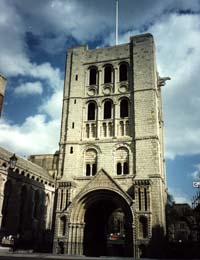 Other sights include: | The Abbey Gate, 14th century gatehouse of the former Abbey, and its nearby counterpart The Norman Tower which forms the belfry of the adjacent Cathedral. The Athenaeum on Angel Hill, former Georgian Assembly Rooms, is famous for public readings by Charles Dickens, as is the nearby Angel Hotel which features in Pickwick Papers. Look out also for the impressive Victorian Corn Exchange on Abbeygate Street, where many of the town's large functions, craft fairs and concerts are staged. The 15th century Guildhall on Guildhall Street is another popular and beautiful meeting place, as is the Unitarian Meeting House on Churchgate Street, built in 1711.
IN THE COUNTRY |
| Bradfield Woods. A splendid example of ancient coppiced woodland, dating back to mediaeval times. A visitor centre and guided walks are provided. |
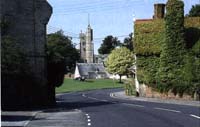 Cavendish is the perfect 'picture postcard' English village with thatched cottages and a 14th-15th century church. It is the home of the Sue Ryder Foundation Museum which tells the story of the institution's beginning and work to date. Nearby is the Cavendish Manor Vineyard which first won prizes for its wine 20 years ago. Visitors can take part in wine tasting and walk around the 15th century manor. |
| Sue Ryder Foundation Museum, Cavendish. A museum depicting the work of Lady Ryder of Warsaw, it tells the story of the institution's beginning and its work to date. | Telephone: 01787 280252.
| Cavendish Manor Vineyard first won prizes for its wine 20 years ago. Visitors can take part in wine tasting and walk around the 15th century manor. | Telephone: 01787 280221
 Clare is a small market town, important in earlier times because of its position at the head of the River Stour, then the gateway to East Anglia - and its 'clear' water, hence its name, Clare. There is much to interest the visitor including the 13th-15th century church, the shell of a 13th century keep and remnants of castle walls, a country park, with riverside walks and nature trail, restaurants, antiques shops and old station buildings.
| Visit the Clare-UK website for more local information.
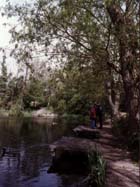 Clare Castle Country Park is Suffolk's oldest public country park. With 25 acres of riverside and woodland walks, it boasts the remains of a Norman Castle with earthworks, motte and moats. | The river Stour flows through the park and 700 metres of mill stream grace its lush setting. Clare's former railway station is situated in the park and forms the visitor centre. As well as riverside and woodland walks there are wildlife ponds, a butterfly garden, a children's play area and picnic facilities. Telephone: 01787 277491
| The 13th century Clare Priory, with its church and cloister ruins, 14th century Friars House, Cellarers Hall and Chapel are set within the grounds of the country park. Today it is run by Augustine Friars as a retreat for pilgrims.
|
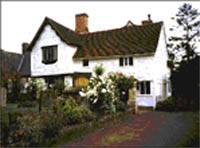 Clare Ancient House Museum is set in the heart of Clare next to the Church. A 15th century grade 1 listed building that houses a museum with the history of Clare. | It includes many exhibits on local culture and computerised records of the 1809 and 1851 census. It also has an exciting collection of historic photographs showing important events in the town's history.
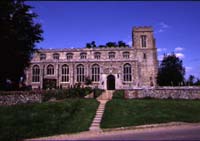 Denston is a tiny village known for its superb 15th century church with fine timbered roof, beautifully carved choir stalls and original mediaeval glass windows. |
| Euston is situated on the Suffolk/Norfolk border and is well known for Euston Hall, home of the Duke and Duchess of Grafton. It houses a large selection of 17th and 18th century paintings, including work by George Stubbs and Sir Anthony Van Dyck. Within the grounds of the surrounding park is Euston church, a rare and beautiful example of an unspoilt 17th century interior with fine plaster ceiling and woodwork. |
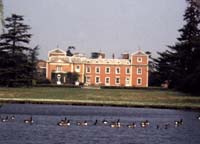 Euston Hall, home of the Duke and Duchess of Grafton, was built in the 1660's by the Earl of Arlington, Secretary of State to Charles II. It became home for the Dukes of Grafton when the Earl's daughter Isabella married Charles II's son, Henry Fitzroy, the first Duke of Grafton. It houses a large selection of 17th and 18th century paintings, including Arlington's fine collection of paintings of Charles II, his family and court, and work by George Stubbs and Sir Anthony Van Dyck. bThe hall is surrounded with beautiful grounds and parkland. | Telephone: 01842 766366
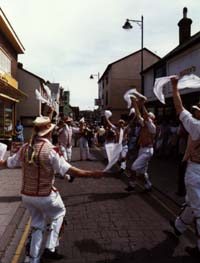 Haverhill is the second largest town and shopping centre in the borough. | Although fire almost razed the town to the ground in 1665, it still has much to offer the architectural enthusiast. Anne of Cleves' House, which once was thought to have formed part of the dowry of the Queen's Consort of England, still stands and has been completely renovated. The town is of interest for its Victorian architecture, local history collection and Town Hall. The 13th century church was severely damaged in the fire of 1665 but was restored in the 19th century. East Town Park, on the eastern side of the town, is ideal for informal countryside recreation. The Town Hall has recently been transformed into an Arts Centre that houses a theatre/cinema, local history centre, art gallery and bistro.
Browse the other sections of this site for more Haverhill related information.
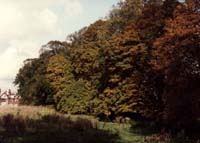 East Town Park, Haverhill. East Town Park is a country park currently being developed on the east side of Haverhill. The park is being established as the centre of a network of footpaths which will extend around Haverhill and along the old railway track, eventually linking up with the newly proposed Dedham Vale and Stour Valley circular walk. | East Town Park has many beautiful mature trees which have been supplemented with a programme of new tree-planting. Facilities already complete are the visitor centre, car park, children's play area for 2 to12 year-olds, the circular walk, old railway walk and footpath network. Regular guided walks around the park include local and natural history. Telephone: 01284 757068
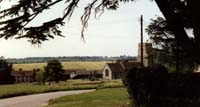 Hawkedon is a lovely village, dominated by the 15th century church which is situated in the middle of the village green, surrounded by a walled churchyard. Inside the porch the visitor can see a handsome carved oak roof dating from the 1400's. Down the aisles oak pews have been skilfully decorated with poppy heads. Look too for evidence of foreign visitations from mediaeval times. It is thought that Hawkedon was a stop off point for pilgrims on their way to Bury Abbey. |
| Hengrave Hall, built by Sir Thomas Kitson in the early 16th century, is said to be one of the country's most delightful houses. It was once owned by the Gage family who introduced a fruit to this country which still bears their name (the greengage). Long used as a conference centre and Christian spiritual retreat, it is now in private hands.
|
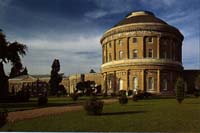 The village of Horringer incorporates Ickworth House, one of the most extraordinary houses in England, with its rotunda and adjoining semi-circular wings. Now owned by the National Trust it still contains a large selection of paintings and Georgian silverware. The grounds include an Italian garden, lakeside walk and woodlands totalling over 100 acres. | For lots of detailed local information visit the Horringer website.
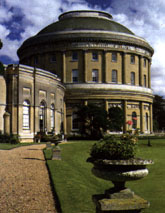 Ickworth House, Horringer. Three miles out of Bury in the village of Horringer stands Ickworth House, with its 100-foot-high oval rotunda begun in 1795 and its collection of fine art, including works by Titian, Gainsborough and Velasquez. Special events throughout the year include open air orchestral concerts, horse trials, car rallies and guided walks.
[Take Eastern Counties bus 141, 142, 143, 144, 146 from the Bus Station, then a 1-mile walk.]. | Telephone: 01284 735270
| Ixworth boasts many buildings of historical importance, including several in the High Street. One is timber framed with two gables and pargetting. Others have attractive Georgian doorways. | St Mary's Church is worth a visit as most of it dates from early mediaeval times and it houses several magnificent Tudor tombs. Visit the Ixworth Village website for more local information.
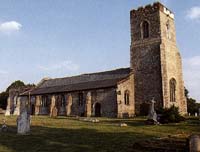
Kedington village on the river Stour is home to a magnificent mediaeval church which has changed little since the three tier Jacobean pulpit was placed in it. There is an extravagant collection of tombs of the local Barnardiston family and fine woodcarvings throughout. |
| Knettishall Country Park has four hundred acres of breckland, heath and woodland which affords the visitor plenty of well-marked-out walks. This is the start of the Peddars Way National Trail. | Telephone: 01473 583179
| Lackford Wildfowl Reserve is an award winning nature reserve which illustrates how worked-out gravel pits can be reclaimed for recreational and conservation purposes. The reserve has several hides and is managed by the Suffolk Wildlife Trust primarily for wildfowl. | 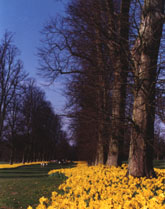 The village of Nowton boasts Nowton Park, which is an excellent example of 19th century landscape. Over 200 acres were developed by the Oakes family over a century ago in typical Victorian style. They planted a magnificent avenue of lime trees which have now been restored to their former glory. Regular events include nature quizzes, treasure hunts and monthly guided walks. An annual country fair is held in June. There are also two football pitches and an all-weather sports pitch. The park is open all year round and admission is free. |
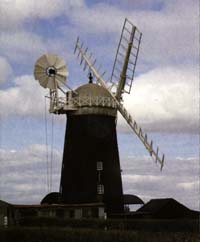 Pakenham is famous as the last British village with both a working watermill and windmill, on a site where corn has been ground for 900 years. A picture of the 18th/19th century brick tower windmill was once used as an interlude scene in BBC TV programmes. | The village also has a 12th century church with a splendid 14th century font. There is also a false window in the vicarage painted by Rex Whistler during World War Two.
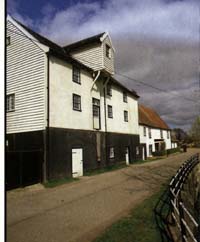 Pakenham Water Mill, Mill Road, Pakenham,Bury St Edmunds | IP31 2NB. A Grade II listed working mill on its Domesday site, complete with oil engine and other subsidiary machinery. [Take Eastern Counties bus 139, 140 (20 mins).] Telephone: 01359 270570, 01359 230629 or 01787 247179 for curator and bookings. Email: suffolk@conservation.u-net.com
| Rede has a lovely Norman church with carved poppy heads on some of the pews. |
| Rougham is where you will find Rougham Airfield, the former home of the 94th Bomb Group of the United States Army Air Force in World War II. B17 Flying Fortresses were operated from the base. The wartime control tower still stands and is being restored to its original state by the Rougham Tower Association. | There is also The Blackthorpe Barn, an expanding art centre based in a large 16th century thatched barn.
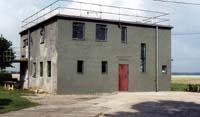 Rougham Control Tower. | You are invited to visit the Old Control Tower at Rougham, last used in anger by the USAFE during the Second World War. The Tower is situated 2 miles east of Bury St Edmunds and is currently undergoing restoration by the Rougham Tower Association. Inside you will find displays and other information available which tell the story of the Tower and its part in the history of the field during World War II. During your visit you will be able to see what progress has been made to date and learn about the history of the Association as well as of the Tower itself. You will also hear about plans for the future to bring Rougham airfield "back to life". The Associations period based Open Day Special Events are developing an excellent reputation throughout the region. They feature wartime aircraft, music, 'forties' memorabilia and a range of activities for the whole family. Telephone: 01359 271471 - Fax: 01359 271555
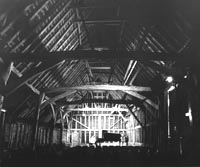 Also found at Rougham isThe Blackthorpe Barn which
is an expanding art centre based in a large 16th century thatched barn, just east of Bury St Edmunds. Each year in May, they commission a site specific installation as part of the Bury St. Edmunds Festival. In July they arrange a season of top class chamber music concerts under the title of Summer Music and in the period before Christmas there are a series of very popular Crafts Markets and the sale of Christmas trees from the Barn.
For further information and to join our free mailing list e-mail barn@rougham.force9.co.uk or telephone 01359 270238 | www.blackthorpebarn.com
| Rushbrooke is a charming village which has a most unusual 16th century church with an interesting story to tell. The building was extensively altered in the 19th century by Colonel Rushbrooke, a keen woodworker, who changed the seating plan to that of a college chapel (seats facing the centre). It is said he often worked through the night in order to complete his work. | Do not be fooled by the name of the Rushbrooke Arms, which is actually sited in Sicklesmere, on the road from Bury to Sudbury. It has extensive parking and outdoor children's play areas.
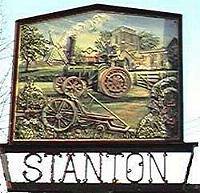 Along the A143 north east of Bury St Edmunds you will find Stanton and Wyken Hall, a romantic Elizabethan Manor House on a farming estate surrounded by four acres of gardens. The adjoining vineyard produces grapes for some of the finest East Anglian wines. The gardens and vineyard are open to the public, and there is a farmers market each Saturday morning. | The village also has a windmill that is one of less than fifty postmills still in existence. Dating from 1751, it was moved in the early 19th century to its current position. Visit the Stanton-Steamer website for more local information.
| Wyken Hall, Stanton.
Seven acres of vines and four acres of gardens surround an Elizabethan manor house and 16th century barn. There is a woodland walk, popular restaurant and country store. Open Thur, Fri, Sun and BH Mon from 2 Feb to 24 Dec. 10am -6pm. For charges, please telephone for details | Telephone: 01359 250240
| Stanton Windmill.
A post mill dating from 1751, in working order. It produces stoneground flour for sale. | Telephone: 01359 250622
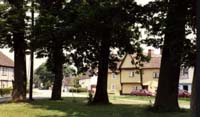 Stoke-by-Clare is a pretty village with a lovely 15th century church and a vineyard. Boyton End Vineyard provides guided tours and wine tasting for visitors or, if you prefer, walk amongst the gardens by the eye-catching Tudor farmhouse. |
 Boyton Vineyard, Hill Farm, Boyton End, Stoke-by-Clare. | This vineyard is set alongside gardens of a listed period farmhouse. Tours of the vineyard can be booked, followed by a talk and wine-tasting session. Telephone: 01440 61893
| Thelnetham has an early 19th century working windmill with conical cap. It is open most Bank Holidays and by appointment and can be seen in action, weather permitting. |
| Thelnetham Water Mill
A 19th Century tower mill, working regularly to produce and sell stoneground flour. | Telephone: 01473 726996 or 01359 250622
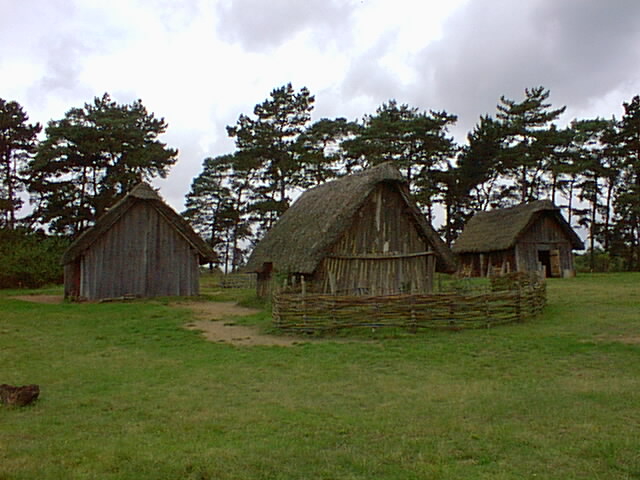
West Stow Country Park, Anglo Saxon Village and Anglo Saxon Centre, Icklingham Road, West Stow, boasts a remarkable reconstruction of six Anglo-Saxon buildings on their original site, built using tools and techniques from the period. The Anglo-Saxon Centre includes an exciting display of archeological finds from local Saxon sites, and there is a bright new cafeteria. There is a children's play area, picnic area and visitor centre. Special events and re-enactments take place during the year. Call for programme of events. The 125 acre park and heathland nature reserve surrounding it is rich in wildlife and excellent for bird-watching, with a nature trail woods, river, lake and bird hides. Take Eastern Counties bus 155 to Lackford, then a 2-mile walk. | Telephone: 01284 728718 Email: weststow@stedsbc.gov.uk
IN SURROUNDING AREAS |
| |||||||||||||||||||||||||||||||||||||||||||||||||||||||||||||||||||||||||||||||||||||||||||||||||||||||||||||||
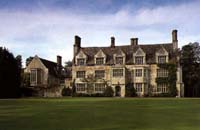 |
Anglesey Abbey, Gardens and Lode Mill, a National Trust property, 6 miles north east of Cambridge. Step into Anglesey Abbey and its gardens and you will soon learn something of its intimate atmosphere, its secrets and surprises. Every season the gardens burst with colour; from the perfumes of the hyacinths and spring bulbs, the rainbow shades of the herbaceous borders and dahlia beds to the exotic trees and plants in autumn. See also the working water mill, the garden statues and the sumptuous paintings and antiques in the house, home of Lord Fairhaven. Telephone: 01223 811200
| |||||||||||||||||||||||||||||||||||||||||||||||||||||||||||||||||||||||||||||||||||||||||||||||||||||||||||||||||||||||||||||||||||||||||||||||||||||||||||||||||||||||||||||||||||||
 |
Imperial War Museum, Duxford, Duxford Airfield, Duxford, Cambridge. Biplanes, Spitfires, Concorde and Gulf War jets are among 140 historic aircraft on show. Duxford retains its wartime atmosphere and, as many of its aeroplanes still fly, you might even see one take to the air. Tanks and artillery are also on show, displayed in dramatic battlefield scenes that you can walk through and Duxford's remarkable new American Air Museum is open to all. Duxford stages world-renowned air shows when spitfires, and old war time planes are usually in flight. Telephone: 01223 835000
| |||||||||||||||||||||||||||||||||||||||||||||||||||||||||||||||||||||||||||||||||||||||||||||||||||||||||||||||||||||||||||||||||||||||||||||||||||||||||||||||||||||||||||||||||||||
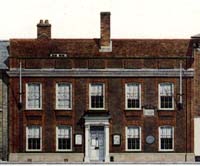 |
Gainsborough's House, Sudbury, Suffolk. Gainsborough's House is the birthplace of Thomas Gainsborough (1727-88) one of England's greatest painters. It is now an art gallery and museum with more of his paintings, drawings and prints on display than anywhere else in the world. The house has a Georgian facade, built by Gainsborough's father, but retains features dating back more than 500 years. The garden's mulberry tree would already have been mature when Gainsborough was a boy. The house also offers a lively programme of contemporary exhibitions, and has a shop selling cards books and souvenirs. There is a fine statue of the famous artist in the town centre, overlooking the Market Hill. Telephone: 01787 372958
| |||||||||||||||||||||||||||||||||||||||||||||||||||||||||||||||||||||||||||||||||||||||||||||||||||||||||||||||||||||||||||||||||||||||||||||||||||||||||||||||||||||||||||||||||||||
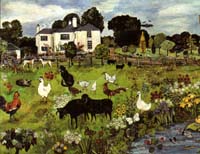 |
Gifford's Hall, Hartest, Suffolk. The home of the Kemp family, set in some of Suffolk's loveliest rolling farmland. Their self-sufficient lifestyle began in 1968 when they planted the first 1000 vines, a few flowers for cutting and a small vegetable garden. It has grown today to a 33 acre smallholding surrounding their lovely Georgian house. The Kemps offer you this invitation: "You are welcome to join us for an afternoon in the country savouring the delights of our way of life." You are free to wander about the smallholding, look at the plants, the wildflowers, the views, and make friends with the animals. Attractions include a vineyard/winery (free tastings), wild flower meadows, organic vegetables, rare breed sheep & chickens, cut flowers including sweet peas, a rose garden and trailer rides. There is a shop, tea room and picnic/play area. Telephone: 01284 830464
| |||||||||||||||||||||||||||||||||||||||||||||||||||||||||||||||||||||||||||||||||||||||||||||||||||||||||||||||||||||||||||||||||||||||||||||||||||||||||||||||||||||||||||||||||||||
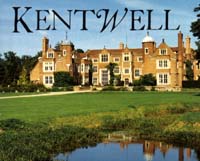 |
Kentwell Hall, Long Melford, Suffolk. A mellow redbrick Tudor Mansion surrounded by a broad moat. A family home with a tranquil atmosphere, described by Country Life as "The epitome of many people's image of an Elizabethan house". See the progress of restoration works carried out by Judith and Patrick Phillips over the past 25 years. Admire the Moat House, a romantic remnant of a 15th century building. Stroll in the gardens, restored and reformed with herb garden and potager in the moated walled garden. Wander through the woods, a profusion of spring bulbs and wonderfully cool in summer. Explore the farm with picturesque timber-framed buildings, home to Kentwell's rare breed farm animals. Award winning re-creations of everyday Tudor life take place on selected weekends throughout the year. Step back in time and see the 16th century come to life. There is a gift shop, lunches and teas are available and there are modern high quality WC's. Telephone: 01787 310207, Seasonal info line 0891 517475
| |||||||||||||||||||||||||||||||||||||||||||||||||||||||||||||||||||||||||||||||||||||||||||||||||||||||||||||||||||||||||||||||||||||||||||||||||||||||||||||||||||||||||||||||||||||
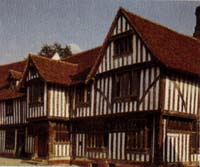 |
Lavenham Guildhall, Lavenham, Suffolk. This splendid 15th century timber-framed Tudor building dominates the market place of the picturesque village of Lavenham with its many historic houses and wonderful church. Here you can see; a unique display of 700 years of the medieval woolen cloth trade, complete with a loom in working order, delightful walled gardens including dye plants used in the wool trade and a restored 19th century parish lock-up and mortuary. There is a shop and lovely tearoom. Telephone: 01787 247646
| |||||||||||||||||||||||||||||||||||||||||||||||||||||||||||||||||||||||||||||||||||||||||||||||||||||||||||||||||||||||||||||||||||||||||||||||||||||||||||||||||||||||||||||||||||||
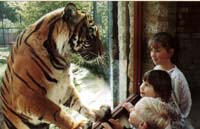 |
Linton Zoo, Linton, Cambridgeshire. Cambridgeshire's wildlife breeding centre. See a wonderful combination of beautiful gardens and wildlife from all over the world. The emphasis is on conservation and education, whilst providing an enjoyable family day out. There's a wealth of rare and exotic creatures to see including Grevy's Zebra, Snow Leopards, Tigers, Lions, Tapir, Binturongs, Toucans, Owls, Parrots, Giant Tortoises, Tarantula Spiders and many others. Set in sixteen acres of beautiful gardens with plenty of picnic areas, a children's play area and all other usual facilities. Telephone: 01223 891308
| |||||||||||||||||||||||||||||||||||||||||||||||||||||||||||||||||||||||||||||||||||||||||||||||||||||||||||||||||||||||||||||||||||||||||||||||||||||||||||||||||||||||||||||||||||||
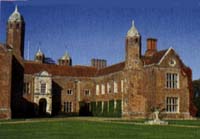 |
Melford Hall, Long Melford, Suffolk. A romantic turreted brick Tudor Mansion near the village green in the unspoilt village of Long Melford. The house has a lovely traditional garden with fine trees and clipped box hedges. Beatrix Potter was related to the family and was a frequent visitor. The Hall dates back to the 1550's, but the house has remains of an earlier hall which was in the ownership of the great Benedictine Abbey at Bury St Edmunds. Attractions include, turreted 19th century gatehouse, original panelled banqueting hall, Regency library, family portraits, Beatrix Potter display, Chinese porcelain and walks in the historic park. Telephone: 01787 880286
| |||||||||||||||||||||||||||||||||||||||||||||||||||||||||||||||||||||||||||||||||||||||||||||||||||||||||||||||||||||||||||||||||||||||||||||||||||||||||||||||||||||||||||||||||||||
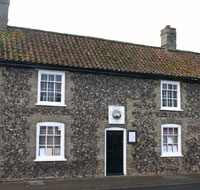 |
Mildenhall Museum has restricted opening hours, but is well worth a visit because it holds full details of the Mildenhall Treasure. The museum is situated opposite Bussens & Parkin, in King Street and there is a large car park not 100 metres away. Forest Heath District Council gave the Museum's Trustees two derelict flint cottages on the corner of King Street and Market Street at a peppercorn rent, together with an interest-free loan for five years to enable the Museum to renovate and adapt the building. The two entrances in Market Street were blocked up and the cottages converted into one building with a large extension covering the site of two wells at the back. The loan was later converted into a grant. Mildenhall Museum, King Street, Mildenhall, Suffolk IP28 7EX Telephone: 01638 716970 Or email - enqs@mildenhallmuseum.co.uk Website - www.mildenhallmuseum.co.uk
| |||||||||||||||||||||||||||||||||||||||||||||||||||||||||||||||||||||||||||||||||||||||||||||||||||||||||||||||||||||||||||||||||||||||||||||||||||||||||||||||||||||||||||||||||||||
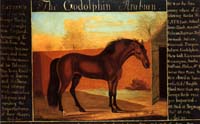 |
National Horseracing Museum and Tours, in the heart of Newmarket, the horseracing capital of the world. The extraordinary story of the people and horses involved in racing from its Royal origins to Lester Piggott, Frankie Dettori and other heros. Hands on gallery includes horse simulator. Equine tours: led by experts steeped in racing - horses training on the gallops, the horses' swimming pool, a training yard and mares and foals at a top stud. There is a gift shop and licensed cafe. Telephone: 01638 667333
| |||||||||||||||||||||||||||||||||||||||||||||||||||||||||||||||||||||||||||||||||||||||||||||||||||||||||||||||||||||||||||||||||||||||||||||||||||||||||||||||||||||||||||||||||||||
| Henry Watson Potteries, Wattisfield.
The Watson family have continued the potting tradition at Wattisfield for nearly 200 years, producing the original Suffolk Pottery of the distinctive terracotta collection. Factory tours are available by appointment, and the shop sells quality seconds. Wattisfield is on the A143 between Bury St Edmunds and Diss. Telephone: 01359 251239 |
| Go to Historical Visits | Updated 16th November 2009 | Go to Home Page |